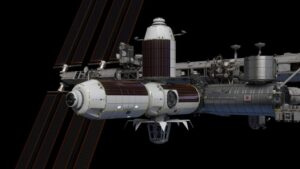White House memo adds low Earth orbit research as R&D priority
By Jeff Foust

WASHINGTON — A White House document has included low Earth orbit research “on new platforms” as a research and development priority for the administration as NASA struggles to win congressional support for its LEO commercialization initiative.
The White House Office of Management and Budget and the Office of Science and Technology Policy jointly released Aug. 14 a memo outlining research and development budget priorities. The memo, released annually, is intended to emphasize programs the administration sees as priorities as agencies develop their fiscal year 2022 budget proposals.
The new memo, like last year’s version, included space as one of five priorities. Much of the language in the new memo is taken word-for-word from last year’s document.
The biggest change, though, is the addition of one sentence in the two-paragraph section about space dealing with LEO research. “Microgravity research in biological and physical science on new platforms in Low Earth Orbit is important to enabling longer duration human missions in space and may have practical benefits to life on Earth,” it states.
The language is the latest evidence of the growing emphasis on the development of commercial facilities that can eventually succeed the International Space Station. NASA stepped up those efforts last year with a LEO commercialization initiative that included both new policies for commercial activities on the ISS as well as support for commercial ISS modules and free-flyer facilities.
That effort included awarding Axiom Space access to an ISS docking port in January. The Houston-based company plans to attach a commercially developed module to that port in 2024, and use that as a hub for future modules. Once the ISS is retired, Axiom will undock that segment and turn it into a standalone commercial space station.
NASA officials have argued that this strategy will help stimulate both development of commercial platforms in LEO as well as demand for them. The agency’s long-term goal is to be one of many customers of future commercial space stations in LEO, carrying out research without the overhead of operating the ISS.
Congress, though, has not been convinced. NASA requested $150 million for LEO commercialization in its fiscal year 2020 budget proposal last year, but Congress ultimately appropriated only $15 million for that effort.
“Congress is definitely telling is that we have not done a good job yet of outlining our vision,” said Doug Loverro, at the time NASA associate administrator for human exploration and operations, in April. “We have not done a good job yet of convincing them of the things that we believe we need to do.”
The agency may still not be doing a good job. NASA again requested $150 million for LEO commercialization in its fiscal year 2021 budget request, but the House version of spending bill again provided only $15 million. The Senate has yet to take up its version of that spending bill.
The section about space in the White House memo makes a few other tweaks. As with last year’s memo, the document reiterates the importance of sending humans back to the moon by 2024, but adds doing so is for “long-term exploration and utilization” as well as being a “proving ground for future human missions to Mars.” Last year’s memo only included the proving ground justification.
The memo lists several technologies and capabilities that agencies should prioritize, such as in situ resource utilization and advanced in-space power and propulsion. The new document adds “orbital debris management” to that list.
The overall document identifies the other research and development priorities as public health and safety, “industries of the future” like artificial intelligence and 5G wireless communications, security, and energy and the environment. While the public health priority specifically discusses work on treatments and vaccines for COVID-19 amid the ongoing pandemic, the memo states that industries of the future “remain the Administration’s top R&D priority.”
August 17, 2020 at 04:52PM
via SpaceNews read more...

Post a Comment